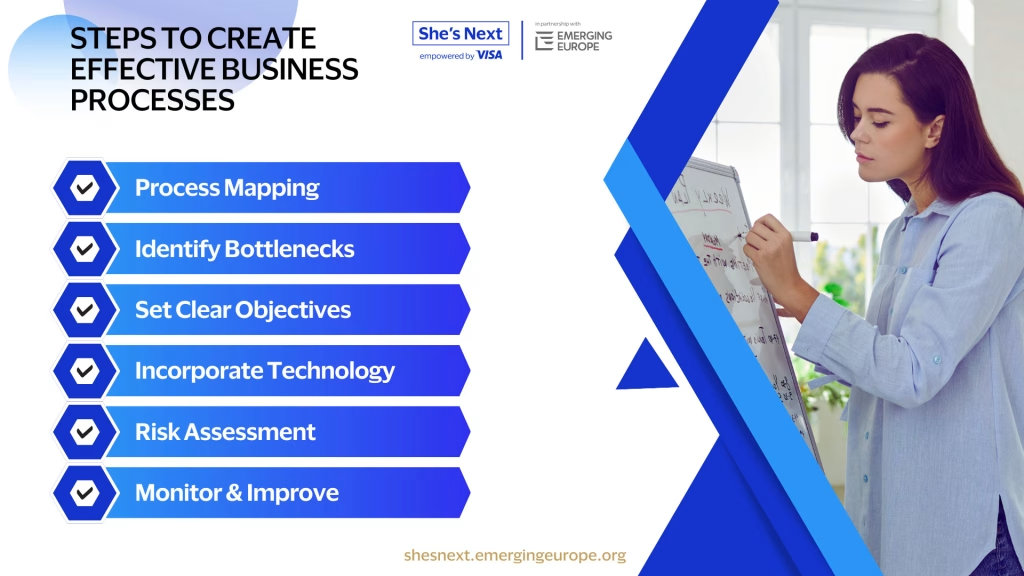
Mastering Efficiency: How to Create Effective Business Processes
Business processes are the backbone of any organisation, providing a structured way to achieve goals efficiently. When well-designed, these processes ensure that tasks are completed in a way that minimises waste, reduces costs, and enhances both productivity and customer satisfaction.
This guide will walk you through how to create effective business processes that can lead to long-term success.
Understanding Business Processes
Business processes are structured activities or tasks that produce a specific service or product for customers. They are crucial because they bring order, improve consistency, and ensure accountability across an organisation.
Here are the three main types of business processes:
Core Processes: These directly contribute to the delivery of products or services. For example, in a manufacturing company, the production process would be a core process.
Support Processes: These do not directly produce outputs but are essential to the smooth running of core processes. HR or IT departments are typical examples.
Management Processes: These involve planning, monitoring, and controlling the business, such as strategy formulation or performance monitoring.
Analysing Existing Processes
Process Mapping
The first step in improving any business process is understanding how it currently works. Process mapping involves creating visual representations of workflows to clearly outline the steps involved in completing a task.
Tools like Lucidchart or Microsoft Visio are great for creating flowcharts that can help you identify how each task flows from one step to the next.
Identifying Bottlenecks
After mapping out the current processes, it’s crucial to identify inefficiencies or bottlenecks. Bottlenecks are steps in a process where delays occur, slowing down the overall workflow.
Techniques like process analysis or root cause analysis can help uncover these issues. For example, if customer service inquiries are taking too long to resolve, it could be due to a lack of clear escalation procedures or outdated technology.
Designing Effective Processes
Setting Objectives
Before designing a new or improved process, it’s essential to set clear and measurable goals. Objectives should align with broader organisational goals and be specific.
For example, if your goal is to reduce customer wait times, a specific objective might be “Decrease average customer wait time by 15% in the next quarter.”
Incorporating Technology
Technology plays a significant role in making processes more efficient. Automation tools like Trello for project management or Zapier for task automation can streamline repetitive tasks.
For instance, automating customer follow-up emails after a purchase can save time and ensure a consistent experience for your customers.

Risk Assessment
Conducting a risk assessment helps foresee potential challenges with new processes. This involves identifying areas where the process might fail and planning mitigations in advance.
For example, when introducing a new software tool, one potential risk could be staff resistance, which can be mitigated with effective training and communication.
Implementing New Processes
Change Management
Implementing new processes requires careful management of change within the organisation. It’s essential to engage stakeholders early, communicate the benefits of the new processes, and address any concerns they may have.
For example, holding regular meetings with key department heads and providing clear communication about the changes can help ease the transition.
Training and Support
Proper training is critical to ensure that employees can adapt to the new processes effectively. This could involve in-person workshops, online tutorials, or access to support teams.
Offering ongoing support is equally important; for instance, setting up a helpdesk to assist staff with the transition ensures they have the resources needed to succeed.
Monitoring and Optimisation
Performance Indicators
After implementing new processes, it’s essential to measure their effectiveness using Key Performance Indicators (KPIs). These could include metrics like processing time, error rates, or customer satisfaction levels.
For instance, in a sales department, KPIs might include lead conversion rates or the time taken to close a deal.
Continuous Improvement
Adopting a continuous improvement mindset ensures that processes remain efficient and effective over time. The PDCA cycle (Plan-Do-Check-Act) is often a useful framework for this. After a new process is implemented (Plan and Do), it should be regularly reviewed (Check) and refined (Act) based on performance data.
For example, if a new inventory management system is showing signs of inefficiency, adjustments can be made to optimise stock levels.
Effective business processes are vital for ensuring long-term organisational success. By continuously reviewing, adapting, and optimising processes in response to new technologies or changing business needs, organisations can stay agile and efficient in a competitive market.
Start by analysing your current processes and embrace a mindset of continuous improvement to keep your business on the path to success.
New Free Courses — Made for Ambitious Women Entrepreneurs!
It’s time to grow smarter, adapt faster, and take your business global.
Explore two powerful courses available exclusively to She’s Next members:
The Reinvention Masterclass for Start-up Founders
Beyond Borders: Building for Global Success
Enroll today — it’s free!






Responses